how to make your own designer clothes
SALE!!! All Pattern Courses HALF OFF through Monday, Nov. 29!
See them all HERE
Use Promo/Coupon code HALFOFF at checkout for your 50% discount
Basic Elements of Clothing Design
If you've always wanted to dabble in clothing design but thought you didn't have the skill or the talent, I'm here to tell you:
You can do it!
If you sew your own clothes from commercial patterns you buy at the fabric store,you already make design decisions regarding style, color, fabric, and details.You make similar decisions when you shop, choosing the styles that have the details you want (that is, if you can find them!)
You can design your own clothes using the same fashion sense you use when you sew or when you shop - and you have total control over the results!
Elements of Design
The design details you'd use to distinguish your style include;
- the shape of the neck and/or collar
- the length, shape and fullness of sleeves (with or without cuffs)
- the shape, length, and fullness of a skirt
- the length, shape and fullness of a top or blouse.
By combining these elements in a "mix and match" fashion, you'll create an endless variety of styles - try a shawl collar with short sleeves, or bell sleeves and a V-neck top. These are simple variations on a basic blouse or top!
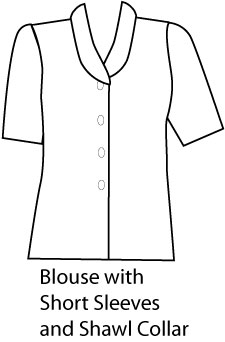
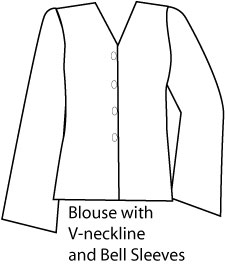
Darts and shaping seams can also be used as design elements – princess seams and shoulder or hip yokes are commonly used design details that also give the garment shape and fit.
Pleats and gathers add fullness and movement. A slim cut skims the body and is more tailored. By "mixing and matching" various design elements, you can come up with an almost endless array of styles.
Ease is the amount of extra fabric allowed for movement and/or style in a garment.Fitting ease (wearing ease) is the minimum amount of room needed for comfort and movement, usually 1 – 1 ½" more than the body measurement.Style ease (design ease) is additional ease added to achieve the desired style (such as a full skirt or a full sleeve, or an oversized silhouette).
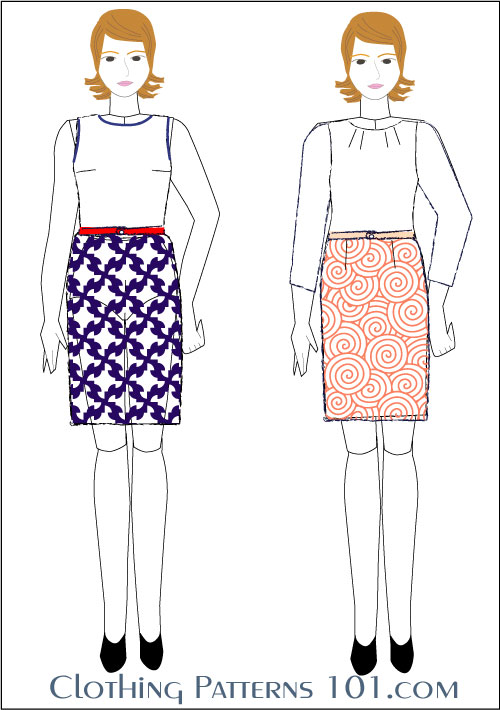
Even the most basic dress can have a variety of looks, depending upon the style details you choose.
For example, both of the dresses at left have the same silhouette - simple, fitted styles with a natural waistline.
But thedifferent colors, prints, and position of the bodice darts (side darts vs. neck darts) help create two entirely different looks. One has sleeves, one is sleeveless with contrast binding - you could add or remove sleeves on either dress for yet another new look.
Add flared skirts, full sleeves, or collars and you have an endless variety of fashions.
Shorten the body into a collection of tops and blouses and pair with skirts or pants - even more style options!
Simple elements, grouped together in varying combinations, are what clothing design is all about.
Finding Your Inspiration
To find inspiration for your designs, look to the past, to other cultures, or just to the latest fashion magazines.
Don't copy directly from another designer, especially if you plan on selling your creations. But focus on a detail that you love, and incorporate that into your design. It can be something as simple as the shape of a neckline, the drape of the bodice, the flare of the skirt - anything that catches your eye (it's bound to catch everyone else's eye in your garment, too!).
I love historic costume, but following a garment from the past feels too "costume-y" to me. I'll use the sleeve and neckline, or shape of the skirt, as inspiration for my own design.
I also love ethnic clothing, but again, want to avoid looking like I'm wearing a costume. Stitching or other decorative details can easily be incorporated into a simple top or dress.
For example, this is a 1920's 2-piece dress that inspires me. I like the wide neck and tapered sleeves, but I especially like the pleats at the left side and the low-slung belt.

This is a kurta, which is a traditional men's tunic from India. It has a stand collar and regular shirt sleeves, but it also has the side pleats I like - and the asymmetrical hem is very modern.
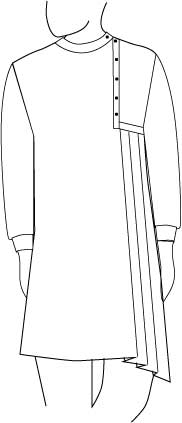
Using the two styles above, I created 2 different tunics utilizing elements from BOTH styles.
The one on the left refers mostly to the men's kurta, but has the more feminine neckline and tapered sleeves taken from the 1920's dress.
The one on the right references the dress, it's been shortened to tunic length with the asymmetrical hem of the kurta. This necessitates raising the belt to the high hip, too.
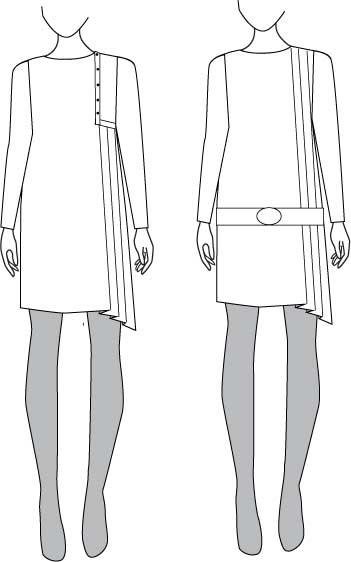
Neither of the tunics I designed are copies, but both retain elements from the historic and ethnic originals.
How to Get Started
So, how to you start designing your own clothes?
Just start sketching! Browse through magazines, make a quick sketch when you see a celebrity wearing something you love, or make a note of a detail as you're watching a TV show or movie.
Then start putting those details together into a garment!
There will be a lot of trial and error - some design elements work well together, some don't - and don't try to put ALL your favorite details into one garment. It's overwhelming and you'll lose focus.
But all you have to do is sketch, sketch, sketch - keep trying different combinations until you find what you really like.
To help with your sketches, I have developed a sketch book, with figure templates (called "croquis") that will make it much easier to draw your styles with proper proportion, and depict movement. Creating a realistic sketch of your idea will help you visualize the style more fully.
The sketch book is available with misses or plus size croquis, and in a full-sheet size (8 1/2" x 11") or a smaller, purse size book
.
Click on the images, below, to go to the item in Amazon.As an Amazon Associate I earn from qualifying purchases. This helps to keep this site free for your use. You are free to search Amazon for these or other similar items without using the affiliate links on this page.


Small Book

Small Book

And add color!! Color can make or break a design. And achange of color - or color combinations -can create a whole new look for the same silhouette!
How can you get a grip on color? With coloring books! (yes, REALLY!!).
These fashion-inspired books, below, are a great start. Just grab some color pencils and go! It's only paper. You can't make a mistake! Try combinations that you think you'd never really wear. You'll be surprised at what works and what doesn't - and how much difference a change of color can make to any garment.
Click on the images, below, to go to the item in Amazon.As an Amazon Associate I earn from qualifying purchases. This helps to keep this site free for your use. You are free to search Amazon for these or other similar items without using the affiliate links on this page.
What's the Next Step?
Step-by-Step: Making and Fitting Your Block
- Make Clothes that Fit You Perfectly
- Using Fitting Patterns
- A Beginner's Guide to Drafting a Dress Block
- Fitting the Bodice Pattern
- Full Bust Adjustment
- Fitting the Sleeve Pattern
- Fitting the Skirt Pattern
- Making Your Personal Pattern Block
- Making a Women's Blouse Block
- Fitting the Pants - Initial Fitting
- Fitting the Pants - Final Fitting
- A Beginner's Guide to Drafting a Pant Block
- The Importance of Sewing Darts
- Pattern Grading
Return to Clothing Patterns 101 Home Page
how to make your own designer clothes
Source: https://www.clothingpatterns101.com/clothing-design.html